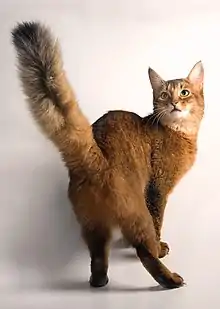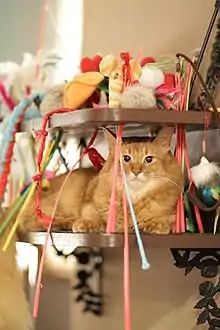Somali cat
The Somali cat is genetically similar to the Abyssinian cat. Due to inheriting 2 copies of the recessive gene for long hair, they have a characteristic luscious coat, unlike their cousin the Abyssinian.
| Somali | |
|---|---|
 A ruddy Somali Cat | |
| Common nicknames | Fox cat; long-haired Abyssinian |
| Breed standards | |
| CFA | standard |
| FIFe | standard |
| TICA | standard |
| ACF | standard |
| ACFA/CAA | standard |
| CCA-AFC | standard |
| GCCF | standard |
| Domestic cat (Felis catus) | |
History
In the 1940s, a British breeder named Janet Robertson exported some Abyssinian kittens to Australia, New Zealand and North America. Descendants of these cats occasionally produced kittens with long or fuzzy coats. In 1963, Mary Mailing, a breeder from Canada, entered one into a local pet show. Ken McGill, the show's judge, asked for one for breeding purposes.
The first known long-haired Abyssinian, named 'Raby Chuffa of Selene', appeared in North America in 1953. Breeders assume that the long-haired gene was passed down through his ancestry. Most breeders were appalled by the sudden difference in appearance in their litters and refused to mention them. However, some breeders were intrigued and continued to breed the long-haired Abyssinian. At first, other Abyssinian breeders looked down upon the new development of the Somali and refused to associate them with the Abyssinian. They worked hard to keep the long-haired gene out of their own cats.[1]
An American Abyssinian breeder Evelyn Mague also received longhairs from her cats, which she named "Somalis". Mague put out a call for other cats to breed with her own long-haired Abyssinians and found the many other breeders internationally that had been breeding long-haired Abyssinians for several years already.[1] Don Richings, another Canadian breeder, used kittens from McGill, and began to work with Mague. The first Somali recognized as such by a fancier organization was Mayling Tutsuta, one of McGill's cats. In 1979, the breed was recognized by the CFA in North America.[2] The new breed was accepted in Europe in 1982.[3] By 1991, the breed was broadly (though not universally) accepted internationally.[4]
The name "Somali" is in reference to the African nation, Somalia. Somalia borders Abyssinia, which is modern day Ethiopia. The name of the breed is a unique interpretation of the Ethiopian-Somali conflict; Mague charitably assumed that since the land borders were a human creation, so are the genetic borders between the Abyssinian cat and the long-haired Abyssinian.[1]
Mague also founded the Somali Cat Club of America, which included members from Canada as well. The SCCA worked to grant the breed championship status by the CFA, which occurred in 1979. In 1975, the CFA founded the International Somali Cat Club.[1]
Appearance
Description
Somalis are recognised for their energetic and social nature. Their appearance with sleek bodies, long tails, and large pointed ears have earned them the nickname of "Fox Cat." Their ticked coats contain between four and twenty colours on each hair are very fine in texture making their coats softer to the touch than those of other cat breeds. The cat itself is medium-large in size.[5][6] Within the GCCF, short haired Somalis are recognised separately from Abyssinian cats.[7]
Colours and patterns
All Somali cats have a ticked tabby pattern. The usual or ruddy coloured Somali has a golden brown ground colour ticked with black, so the official genetic term is black ticked tabby. The coat colour names in Somalis refer to the ticking colour. There are 28 colours of Somali in total although certain organisations accept only some of these colours. All organisations that register Somalis permit usual (genetically black, a.k.a. ruddy or tawny in Somalis), blue, sorrel (genetically cinnamon, a.k.a. red in Somalis), and fawn. Most clubs also recognise usual/ruddy silver, blue silver, sorrel/red silver, and fawn silver. Other colours that may be accepted by some registries include chocolate, lilac, red, cream, usual-tortie, blue-tortie, sorrel-tortie, fawn-tortie, chocolate-tortie, lilac-tortie, and silver variants of these (e.g. blue-tortie silver).
Health
The Somali cat is usually healthy, with few breed-related health issues, though some problems may occur. These include gingivitis, tooth decay, and renal amyloidosis, which are also seen in many other breeds of cats. Renal amyloidosis (often called RA) is a condition in which there is a deposition of the protein amyloid in various tissues which hinders that part of the body's normal functioning.[8] Other problems that are prevalent in most cat breeds, the Somali included, are feline infectious anemia (FIA) and autoimmune-mediated hemolytic anemia (AIHA).[1] Some AIHA-related diseases are inherited erythrocyte disorders, such as pyruvate kinase deficiency and osmotic fragility.
Recently found in cats has been myelodysplasia. It is normally known to affect humans but was recently found in a litter of Somali kittens. Like AIHA, myelodysplasia causes anemia and is speculated to be the cause of anemia in Somalis in the past.[9][10]
Somalis may also have hereditary retinal degeneration due to a mutation in the rdAc allele. This mutation is also seen in Abyssinians, Siamese cats, and other related breeds.[11]
Coat colour overview
 Ruddy Somali
Ruddy Somali Ruddy Somali female
Ruddy Somali female Ruddy (usual) Somali kitten
Ruddy (usual) Somali kitten Blue Somali kitten
Blue Somali kitten_Somali_-_20060816.jpg.webp) Sorrel Somali
Sorrel Somali Fawn Somali
Fawn Somali Lilac Somali
Lilac Somali Female Somali in a cat café
Female Somali in a cat café
References
- Edwards, Alan (2005) [1999]. The Ultimate Encyclopedia of Cats Cat Breeds & Cat Care. Trevor Turner (Consultant) John Daniels (Photographer). London: Hermes House. ISBN 978-0-7548-1277-7. OCLC 76934417.
- "Somali Cats | Somali Cat Breed Info & Pictures | petMD". www.petmd.com. Retrieved 2016-04-15.
- "Breed Profile: The Somali". cfa.org. Retrieved 2016-04-13.
- "Le Chat Somali". www.micetto.com. Retrieved 2016-04-21.
- Fogle, Bruce (2001) [1997]. The Encyclopedia of the Cat: The Definitive Visual Guide. Dorling Kindersly Pr. p. 224. ISBN 978-1-4053-3490-7.
- "Somali". Animal Planet. Retrieved 2016-04-11.
- Stephens, Gloria; Yamazaki, Tetsu (1990). Legacy of the Cat. San Francisco: Chronicle.
- "Coat types and colours". Somali Cat Club.
- "Protein Deposits in Liver (Amyloidosis) in Cats | petMD". www.petmd.com. Retrieved 2016-04-15.
- "Somali Cat Club of America, Inc". www.ladybear.com. Retrieved 2016-04-22.
- "Cat Breed Profile: Somali - Petful". Petful. Retrieved 2016-04-22.
- Narfström, Kristina; David, Victor; Jarret, Oswald; Beatty, Julia; Barrs, Vanessa; Wilkie, David; O’Brien, Stephen; Menotti-Raymond, Marilyn (2009-09-01). "Retinal degeneration in the Abyssinian and Somali cat (rdAc): correlation between genotype and phenotype and rdAc allele frequency in two continents". Veterinary Ophthalmology. 12 (5): 285–291. doi:10.1111/j.1463-5224.2009.00710.x. ISSN 1463-5224. PMID 19751487.